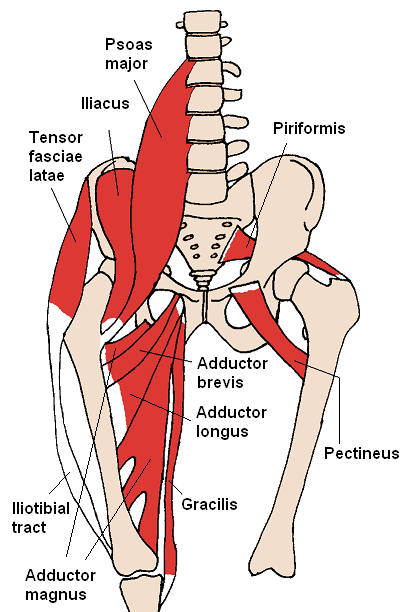I have not really forgotten about the hip series.
Okay, I may have really forgotten about the hip series. Or at least pushed it to the back burner.
But I’m back and am ready to talk about the external hip rotators.
First off, when I say “external” hip rotation, I’m talking about the hip motion that would turn one’s toes and kneecap out to the side.
Second, there are a couple of muscles we’ve already covered that moonlight as external rotators. They are:
- the psoas
- the gluteus maximus

“Anterior Hip Muscles 2″ by Beth ohara. Own work. Uploaded to Wikimedia Commons on 31 January 2006. Shared via Creative Commons 3.0 License.
There is also a lateral (external) rotator group of smaller muscles that primarily do external hip rotation. They are:
- The piriformis, which originates on each side of the sacrum and attaches on the top of the femur. I hear a lot about the piriformis in pigeon pose specifically. So, yeah, something to look forward to.
- Gemellus superior and gemellus inferior. Each extends from the ischium (the “sitting bone” area of the pelvis) and attaches onto the top of the femur.
- The obturator internus, which actually originates on the inside of the pelvis and wraps around each sitting bone to attach to the back of the femur head on each side.
- The obturator externus, on the other hand, starts out where the ischium and the pubic bones meet and — like all these rotators so far — attaches to the head of the thigh bone.
- Finally, the quadratus femoris is a shorter but wider muscle, going from the ischial tuberosity (the actual “sit bone”) to the femur just below the head.
If I’m summarizing correctly, I’m seeing — if I include the psosas and the glutes — muscles that start on the lumbar spine, the sacrum, the ilium, the ischium, and the pubic bones. Those same muscles also attach to the front, top, and back of the femur head; the top of the femur itself; and the IT band.
Is it just me, or is there a possibility that external hip rotation is a complicated process?

